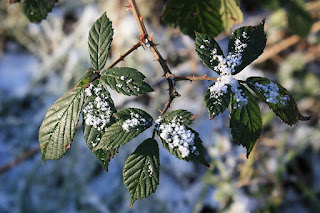 Whilst munching my way through a cold venison and piccalilli sandwich this boxing day, I cast my mind back to the last course I'd run, which had been mid December in Gloucestershire. There was snow on the ground then too and I remember distinctly standing around explaining, as I do, that there was still food to be foraged to the apparent disbelief of the clients who had basically resigned themselves to an evening meal of snow and icy mud pies.
Whilst munching my way through a cold venison and piccalilli sandwich this boxing day, I cast my mind back to the last course I'd run, which had been mid December in Gloucestershire. There was snow on the ground then too and I remember distinctly standing around explaining, as I do, that there was still food to be foraged to the apparent disbelief of the clients who had basically resigned themselves to an evening meal of snow and icy mud pies.There are around ten thousand edible species in Europe alone. Early man in England would routinely use a couple of hundred wild foods, whereas modern man uses far less. Thankfully, you don't need to know hundreds of plants in order survive; just think for a moment about the number of different vegetables an average teenager eats, they don't die from that diet, so there is no reason to die from what seems like a limited diet in the wild. If you know six or seven prolific plants in your area which cover a range of types then survival is possible.
Season is just one of the factors which affect wild food availability, and winter does pose a challenge, but it doesn't mean there is nothing. On that particular week, we came across:
 |
| Bramble |
- Nettle
- Bramble
- Dandelion
- Sorrel
- Plantains
- Silverweed
- Burdock
- Rose Hips
- Haws
- Beech Nuts (very few)
- Jew's Ear
That's a fantastic selection of leaves, roots, tubers, nuts, fruit, seeds and fungi giving anyone a good balanced diet in a survival situation. The clients were genuinely surprised as to how many of them they already recognised and the fact that a diet of these alone would be sufficient to live.
Of course, there are many more wild edibles available in the winter months, but they generally don't all hang out together. We were in a mid successional woodland consisting mainly of Beech and Hazel. There is no Pine there, for instance, which is an excellent source of Vitamin C throughout the year.
Don't be concerned about learning every single wild edible, it's a never ending task and though enjoyable, can be seen as a mammoth task which many people give up on before they start. Instead, learn enough plants so that you'll find half a dozen or so at any time of year. If you're lucky enough to be trekking through an unusual environment, like the rain forest of South America, take the time to learn a dozen plants which you could eat, should you be unfortunate enough to find yourself in a genuine survival situation.